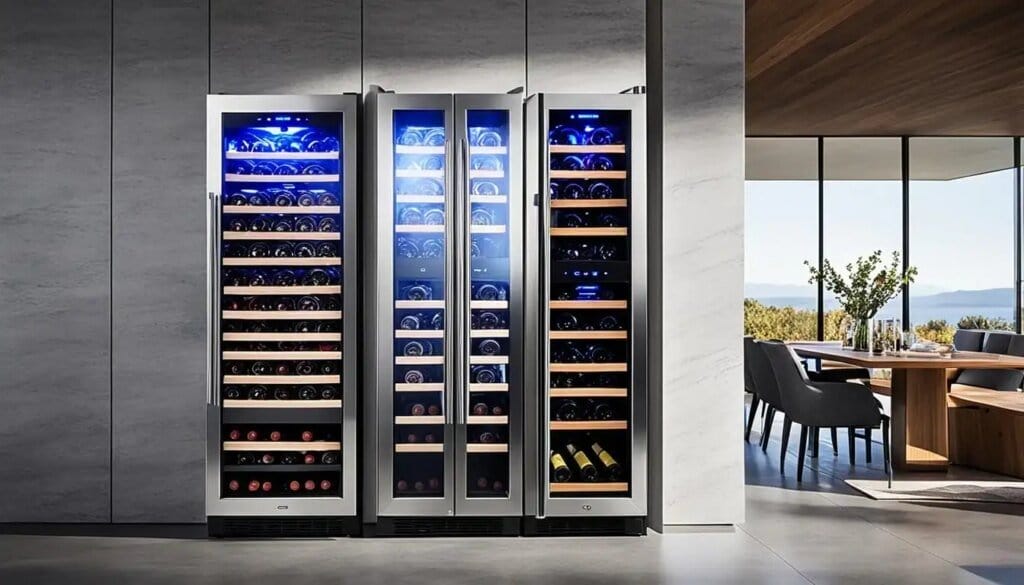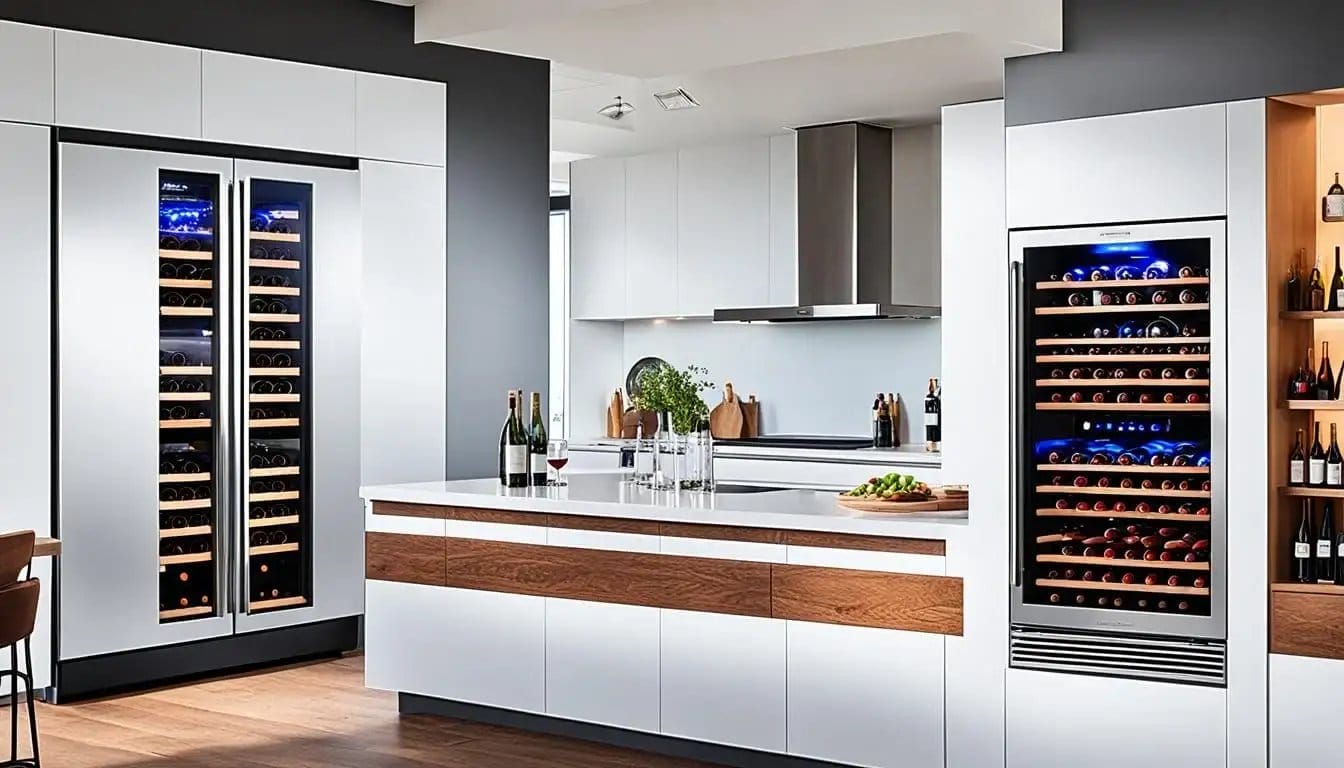In this guide, I will uncover the key differences between freestanding and built-in wine coolers, guiding you towards selecting the perfect wine storage solution for your needs.
From exploring placement and ventilation requirements to evaluating the benefits and challenges, join me as we go through the world of wine fridges and make an informed choice for your valuable wine collection.
Key Takeaways:
- Understanding the differences between freestanding and built-in wine fridges is crucial for making an informed decision.
- Placement and ventilation requirements vary between freestanding and built-in wine fridges.
- Freestanding wine coolers offer cost-effectiveness, placement flexibility, and a variety of sizes.
- Built-in wine coolers provide a custom look, temperature regulation advantages, and longevity.
- Consider your budget, available space, desired customization, and long-term storage needs when choosing between freestanding and built-in wine fridges.
What Sets Freestanding And Built-In Wine Fridges Apart
When it comes to choosing a wine fridge, understanding the differences between freestanding and built-in options is crucial. These two types of wine fridges vary in terms of placement and ventilation requirements, making them suitable for different scenarios.
1. Placement Of The Fridges
- Freestanding wine fridges are standalone units that can be placed anywhere in your home. Whether it’s in the living room, kitchen, or even the basement, you have the flexibility to position it wherever is most convenient for you.
- Built-in wine fridges are designed to be installed into existing cabinetry. This allows them to seamlessly blend in with your kitchen or bar area, creating a cohesive look.
2. Ventilation Of The Fridges
Freestanding and built-in wine fridges also have distinct ventilation requirements.
- Built-in wine fridges require proper ventilation to prevent overheating, as they are enclosed within cabinetry. The lack of adequate airflow can affect their cooling performance and potentially lead to malfunctions.
- Freestanding wine fridges, on the other hand, have more ventilation freedom due to their standalone design, which allows for more efficient cooling.
It’s worth noting that proper ventilation is important for both types of wine fridges to ensure optimal cooling and longevity. However, the venting requirements for built-in wine fridges should be carefully considered during installation to ensure they operate at their best.
Freestanding Wine Coolers: The Benefits & Challenges
Freestanding wine coolers offer several benefits and challenges that make them a popular choice for wine enthusiasts. Let’s explore the advantages and disadvantages of investing in a freestanding wine cooler.
1. Cost-Effectiveness And Installation Ease
One of the primary benefits of freestanding wine coolers is their cost-effectiveness.
- Compared to built-in options, freestanding wine coolers are generally more affordable, making them a great choice for those on a budget.
- Their installation is hassle-free, as they are not required to be integrated into existing cabinetry. This ease of installation ensures that you can enjoy your wine collection without the need for extensive renovations.
2. Placement Flexibility And Room Considerations
- Freestanding wine coolers provide flexibility in terms of placement. They can be easily positioned in various locations within your home, such as the kitchen, dining room, or even the living room.
- This flexibility allows you to create a dedicated wine storage space that suits your specific needs and preferences.
- Moreover, freestanding wine coolers accommodate different room considerations, making them a versatile choice for any home.
3. Energy Efficiency
- Energy efficiency is another advantage of freestanding wine coolers.
- These appliances are designed to optimize energy consumption, helping you save on electricity bills while maintaining the perfect temperature for your wine collection.
4. Cons Of Freestanding Wine Fridges
Freestanding wine coolers do have some challenges to consider.
- Limited customization options: Freestanding wine fridges may have limited customization features compared to built-in units. If you are looking for a wine storage solution that seamlessly integrates with your existing cabinetry or allows for specific design preferences, a freestanding wine cooler might not offer as much flexibility in terms of customization.
- Placement flexibility restrictions: Unlike built-in wine coolers that can be integrated into existing cabinetry, freestanding wine fridges have more limited placement options. They need to be positioned in a standalone manner, which can sometimes restrict where you can place them within your home. This limitation might be a drawback for those looking for a more integrated look.
- Aesthetics: While freestanding wine coolers come in various sizes and designs, they may not always provide the same level of aesthetic appeal as built-in models. If aesthetics and seamless integration with your home decor are top priorities for you, a freestanding wine fridge might not offer the sleek and custom look that a built-in unit can provide.

Built-In Wine Coolers: The Benefits & Challenges
Built-in wine fridges offer a range of benefits and challenges. Let’s take a closer look at what sets them apart.
1. Designed For Cabinetry: Creating A Custom Look
- Built-in wine coolers are specifically designed to seamlessly blend with your existing cabinetry.
- They create a custom and integrated look in your kitchen or entertainment area.
- With their sleek and stylish appearance, they can enhance the overall aesthetic of the space.
2. Advantages In Temperature Regulation And Longevity
Another advantage of built-in wine coolers is their superior temperature regulation compared to freestanding wine fridges.
- Built-in models are often equipped with advanced cooling technology.
- They allow precise temperature control and maintain optimal storage conditions for your wine collection.
- This improved temperature stability can significantly impact the longevity and quality of your wines.
3. Cons Of Built-In Wine Fridges
While built-in wine coolers offer many benefits, there are some challenges to consider.
- More expensive: One of the main drawbacks is the higher cost compared to freestanding wine fridges. The integration and customization features of built-in wine coolers often come with a premium price tag.
- More complex installation requirements: Built-in wine coolers require proper installation to ensure optimal performance. This may involve professional installation service, such as the need for a dedicated power source, proper ventilation, and professional assistance for the installation to avoid any potential issues.
- Placement flexibility restrictions: Built-in wine fridges lack flexibility in terms of placement. Once installed, they are not easily movable or transferable to another location. This limits the options for reconfiguring your space in the future.
Making An Informed Decision: Freestanding vs Built-In Wine Fridge
Choosing between a freestanding and built-in wine fridge requires careful consideration of several factors to ensure you make the right choice for your wine collection.
By weighing the benefits and challenges of each type and taking your specific requirements into account, you can confidently select the perfect wine fridge that suits your needs.
Consider the following factors:
- Your budget: Determine the amount you are willing to invest in a wine fridge. Freestanding wine coolers tend to be more cost-effective compared to built-in units.
- Available space: Evaluate the dimensions of the area where you plan to install the wine fridge. Built-in wine coolers require proper cabinetry integration, whereas freestanding wine fridges offer more flexibility in terms of placement.
- Desired customization: Consider the level of customization you desire. Built-in wine fridges are designed to seamlessly blend with your existing cabinetry, creating a sleek and customized look.
- Long-term storage needs: Determine if you require long-term storage for your wine collection. Built-in wine coolers typically offer better temperature control and longevity.
By thoroughly evaluating these factors, you can make an informed decision and choose between a freestanding and built-in wine fridge that perfectly suits your preferences and requirements.

Bottom Line
Overall, when choosing between a freestanding and built-in wine fridge, it is essential to consider your specific needs and preferences.
- Freestanding wine coolers offer cost-effectiveness and flexibility in placement. These standalone units can be placed anywhere in your home, allowing you to easily adapt to changing room layouts or decor. They are a great option if you want the freedom to move your wine fridge around or if you have limited space within your cabinetry.
- Built-in wine coolers provide a custom look and offer benefits in temperature regulation. They are designed to seamlessly blend with your existing cabinetry, creating an elegant and integrated appearance. Built-in wine fridges are ideal for those who prioritize aesthetics and want their wine collection to be a focal point in their kitchen or bar area.
Take into account your budget, available space, and long-term storage needs. Both these two fridges can provide optimal storage conditions for your favorite wines, so choose the option that best suits your requirements.
Cheers to finding the perfect wine fridge to preserve and enjoy your collection!
Happy cooling!
FoodiesFridge









